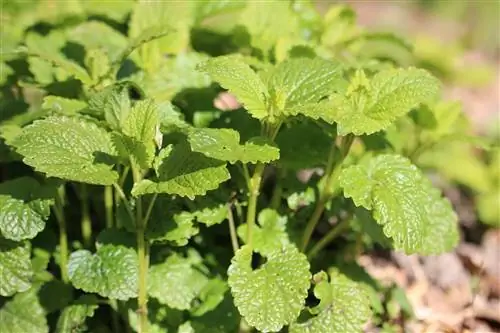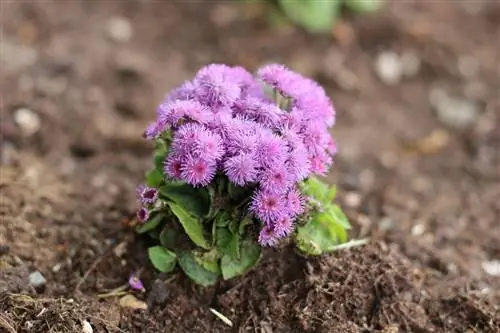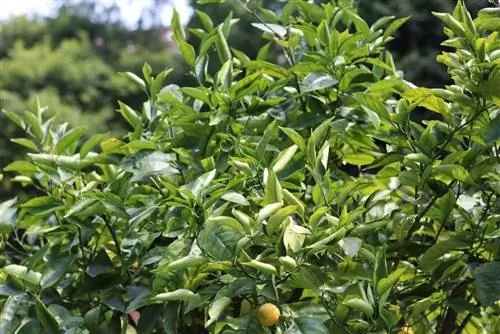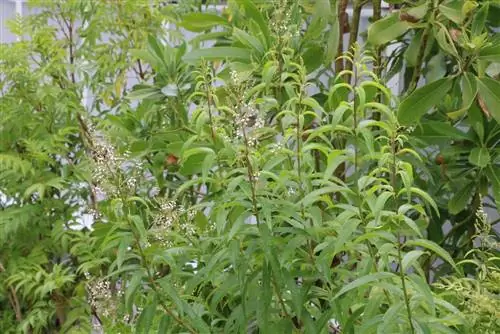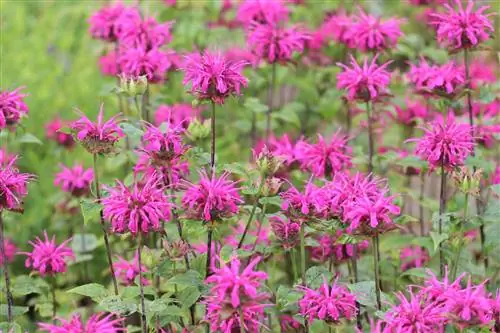- Author admin [email protected].
- Public 2023-12-17 03:39.
- Last modified 2025-06-01 06:48.
You can sow it or plant it outdoors as a young plant; it thrives on the balcony, on the windowsill and even in the kitchen. Lemon balm is easy to keep if you follow a few simple rules. With good care, the plants can live up to twenty years and can be harvested four times per season. However, lemon balm also likes to spread widely in the garden.
Location
Lemon balm is frugal and grateful; the plants do not require a special location. The culinary herb actually feels at home everywhere on the windowsill, on the balcony, on the terrace and even outdoors. However, it thrives better in a sunny to partially shaded location and it needs a lot of space. Places protected from the wind are advantageous because the stems, which are up to 120 cm high and have broad leaves, break in strong gusts.
Substrate and soil
Lemon balm is also not spoiled when it comes to soil. The plants thrive in large pots or tubs in herbal soil, a loose, slightly humus-rich soil that absorbs water but does not form waterlogging. Nutrient-rich soils are good for lemon balm, it also likes sandy loamy soils and loamy sandy soils. Acidic, neutral or calcareous soil is fine, the plant doesn't care about any of that. The only thing the herb doesn't like is waterlogging; the moisture has to be able to drain away. A drainage layer must be installed in the pot and bucket. Coarse pebbles and pottery shards are very suitable for this. Outdoors, the soil can be mixed with some humus or sand to improve water permeability.
Watering and fertilizing
Lemon balm does not need a lot of water, the adult plants can also cope with prolonged drought. However, the plants feel most comfortable when they are kept evenly moist, so the soil never gets completely dry but is never wet either. Like most herbs, lemon balm does not tolerate waterlogging. Young plants must not become dry and the soil must always be kept moist. And lemon balm is not fertilized either; it gets all the nutrients it needs from water and soil. This also applies to lemon balm, which thrives in a pot or bucket - if the plants are transplanted into a slightly larger pot in the spring and receive new soil, that is sufficient.
Propagate
Lemon balm can be sown outdoors from the end of May, i.e. after the Ice Saints. The seeds are scattered on the ground and only pressed lightly; they must not be covered with soil. Lemon balm germinates quickly, but often has problems finding its way out of the soil. And the plants take a long time to form roots. During this time, lemon balm always needs moist, loose soil. Once the plants have grown, they are not a problem. Lemon balm can also be propagated through seedlings or cuttings.
To do this, shoots are cut about a hand's width above the ground and are rooted under cling film and in high humidity. Once the roots have developed, the plants can be placed in the ground. It's even easier to simply divide the lemon balm in the spring when repotting, divide it outdoors in the spring or let it bloom. The seeds fall out and at least some of them grow into new plants, all alone and without work. Lemon balm often forms underground rhizomes outdoors from which new plants are produced. If this is undesirable, a root barrier must be incorporated. Adult plants need a distance of about 35 cm from each other.
Wintering
The plants are generally perennial and hardy, so they can remain outdoors. In autumn they are cut back to about a hand's width above the ground and they sprout again in spring. Of course, in extremely cold weather you can also cover the plants with brushwood or pine branches. If the lemon balm is kept in a bucket or pot, the container should be placed on a Styrofoam plate in winter and wrapped with jute fabric. Of course, the plants can also overwinter indoors, but then they like it cool and dark.
Harvest
Lemon balm can be harvested for the first time in the year of sowing in late summer. To do this, the plants are cut about a hand's width above the ground, the leaves are dried quickly, protected from sunlight and in an airy place. Mature plants allow up to four harvests per year. Lemon balm leaves are most aromatic when harvested directly before flowering. The aroma loses a little as the flower blooms, and it is also lost when dried. It is richest when used fresh.
My personal tip
So that the lemon balm grows quickly in spring and can be harvested soon, it should be sown on the windowsill in a mini greenhouse the previous autumn. Seeds can be bought commercially or grown yourself, it doesn't matter. As soon as not only cotyledons but the correct plant leaves appear, the greenhouse can remain open on the windowsill. It is important that the plants in the heated room always have sufficient light and water available. In spring they can spend the first mild days on the balcony or terrace to slowly get used to the ambient temperature. As soon as the nights are guaranteed to be frost-free, the now almost fully grown plants can be placed outdoors.
Frequently asked questions
Is lemon balm attacked by pests?
Yes, she will. Although lemon balm is very robust and not very susceptible, there are a few things that it can catch. Powdery mildew, leaf spot and rust are among them, but scale insects and aphids also like lemon balm. Bugs, cicadas and the green shield beetle also love the plant.
What do you do if you have a pest infestation?
Since it is a culinary herb that is also intended for consumption, insecticides should not be used if possible. Pests such as lice and bedbugs, beetles and cicadas can be collected and removed upon first sighting. If you catch everyone, the problem is solved. Fungal diseases of lemon balm are defeated by radical pruning. Infected leaves may no longer be used in the kitchen. Except for powdery mildew, the affected plant parts must not be composted because the fungi can also spread through dead plant parts.
If home remedies don’t help - can a specialist do it?
Yes, the specialist, i.e. gardener, can usually help. There are fungicides against fungal diseases, but they should only be used if the plants are not used in the kitchen. This also applies if insects have to be combated with chemicals, so-called insecticides. These chemicals should always be the last resort when all else has failed. They can save the lives of plants, but are harmful to people and the environment.
When can I cut and dry the leaves?
Lemon balm can actually be cut at any time when it is fully grown. It is important that the leaves are dry, as this makes them easier to preserve. But the plant is most aromatic right before it flowers and is used fresh - for compotes, infused drinks or as decoration in the kitchen.
What you should know about lemon balm in brief
Profile
- Lemon balm is a popular herb for cooking and also as a medicine, not least because of its aromatic lemon scent.
- The perennial plant can be harvested several times a year and usually overwinters without any problems.
- Lemon balm blooms between June and August and produces an intense lemon scent when rubbed between the fingers.
- The flowers are usually white, light yellow or purple. The whole plant reaches a height of around 60 cm.
- In particularly favorable locations it can even grow to a meter high.
Location
- In nature, a sunny location with loamy, nutrient-rich soil is best.
- If you grow lemon balm on the balcony or in the bed, you should make sure that it is at least in partial shade.
- When cultivating lemon balm, it is advisable to mix sand into the soil to loosen the soil.
- Dryness doesn't bother lemon balm as much as wetness, so waterlogging should never occur.
- No matter whether acidic, neutral or alkaline, lemon balm generally thrives in soils of all pH values.
Sowing
- Spring, especially the month of May, is the optimal time for sowing.
- Lemon balm is a light germinator, so the seeds should only be lightly pressed and not covered with soil.
However, like many mint plants, lemon balm also has a poorly developed root system, which significantly reduces the chances of survival of each individual seed and even the smaller cuttings. Nevertheless, those plants that receive enough nutrients and light survive. These grow quickly so that the first harvest can be carried out after just one and a half to two months. Many varieties only grow as upright plants after they have been cut back for the first time, which makes cultivation a little more space-saving.
Tip:
Another option for cultivation is sowing in autumn, which then no longer produces a harvest in the same year - but this has the advantage that the plants grow upright from the start of the next sprouting in spring.
Care tips
The following care tips should make it easier for hobby gardeners to enjoy growing lemon balm in the long term:
- Waterlogging should be avoided at all costs.
- Lemon balm loves slightly sandier soils and very sunny places.
- Lemon balm is one of the so-called “self-seeders”, which means that the plant usually multiplies itself strongly once it is cultivated, so that it only needs to be transplanted in the spring.
- The plant should be cut back in spring so that it can sprout well and upright again.
- To propagate an existing lemon balm, the perennial can be divided and transplanted in spring.
Using lemon balm
In order to get the best harvest results, it is recommended to cut back the lemon balm shortly before it blooms, as this is when the plant's aromatic substances are most clearly visible. The leaves can be used as a spice for salads, for example, or are a helpful remedy for heart, circulatory or gastrointestinal problems. Dried herbal leaves quickly lose their aroma, but the healing properties remain unchanged.

